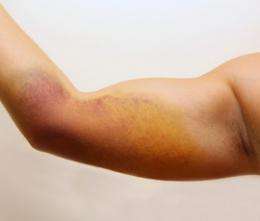Forensics' evidence could be bruised

(�鶹��ԺOrg.com) -- Criminal cases where forensic experts determine the age of bruises on victims from photographs could be flawed, according to scientific research.
Researchers from Barts and The London School of Medicine and Dentistry at Queen Mary, University of London found forensic experts made significant errors when they used photographs to determine the time bruises were inflicted on people.
One of the study’s authors, Professor of Forensic Medical Sciences, Peter Vanezis, at the William Harvey Research Institute, Barts and the London School of Medicine and Dentistry, said: “Forensics are often asked to give their expert opinion as to when bruising had occurred on a victim based on photographic images, yet we now realise they can’t accurately determine when the bruise occurred.”
Forensic experts are frequently asked to comment on the age of bruises, in cases concerning child abuse, assault and sexual assault.
In this study, forensic experts looked at 132 photographic images of bruises, ranging from 0 to 209 hours in age.
Bruises were produced on the upper arms of 11 Caucasian subjects by a suction pump. Daily sequential photographs were taken until they were no longer visible to the naked eye. Fifteen forensic experts were asked to estimate the age of the bruises and also place them in chronological order.
Lead author, Margaret Pilling, an Honours Medical Student at Barts and the London School of Medicine and Dentistry, said: “The greatest accuracy, from forensic experts, occurred in very fresh bruises (between 0 and 12 hours) however there were still a number of significant misjudgements in this age range.
“The median difference between the estimated age and the real age was 26 hours - a considerable disparity. We conclude that forensic experts’ estimates of bruise age from photographs are, at best, unreliable.”
More information: “Visual assessment of the timing of bruising by forensic experts” Pilling M.L., et al, Journal of Forensic and Legal Medicine 17, 2010, 143-149.
Provided by Queen Mary, University of London















